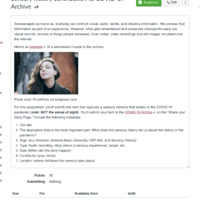Item
The Day the Call to Prayer Changed in Cairo
Media
Title (Dublin Core)
The Day the Call to Prayer Changed in Cairo
Disclaimer (Dublin Core)
DISCLAIMER: This item may have been submitted in response to a school assignment prompt. See Linked Data.
Description (Dublin Core)
If there's one thing you can count on in the Muslim world, it's the call to prayer (adhan) audibly marking the sun's path through the sky, and everyone's route to a mosque, five times a day. It might sound a little different in various regions, a little more musical in Egypt, a little less practiced sometimes in Kyrgyzstan, but it's always the call to prayer, and has been for over 1000 years. But across the Muslim world in March 2020, as mosques closed because of the coronavirus pandemic, the call to prayer was adapted. Instead of saying, "Come to prayer, come to salvation" it said in Egypt, "Pray in your homes, pray on your travels." The wording had been changed like this a few times in the past when mosques were closed because of war or plague or weather, but I honestly never thought I'd hear it myself. The call to prayer seems constant and unchanging, part of the highly sensory experience of Muslim prayer, so this adaptation made the pandemic more present for everyone in Egypt.
I'm not Muslim myself, but I talked with Muslim friends all over the world about the change in the adhan. One woman in Kuwait said, "It just sounds so... ominous.. especially at maghrib prayer, it's sunset and getting dark, and the voice over the loudspeakers is saying to stay home... also because I have never, ever heard them change it like this before. Ever. It's like I'm waiting for an eclipse, and the flocks of birds flying away, animals fleeing, etc."
I took this video during the last prayer of the day on 21 March 2020 at a mosque near our apartment in Cairo, Egypt. If you're not familiar with the adhan, you obviously won't notice anything different, but this rendition is beautiful even if you don't understand it. If you do, the new wording begins at 1:13. The beginning of the video is a little bumpy while we were getting to the right spot, but then it settles down a bit.
I'm not Muslim myself, but I talked with Muslim friends all over the world about the change in the adhan. One woman in Kuwait said, "It just sounds so... ominous.. especially at maghrib prayer, it's sunset and getting dark, and the voice over the loudspeakers is saying to stay home... also because I have never, ever heard them change it like this before. Ever. It's like I'm waiting for an eclipse, and the flocks of birds flying away, animals fleeing, etc."
I took this video during the last prayer of the day on 21 March 2020 at a mosque near our apartment in Cairo, Egypt. If you're not familiar with the adhan, you obviously won't notice anything different, but this rendition is beautiful even if you don't understand it. If you do, the new wording begins at 1:13. The beginning of the video is a little bumpy while we were getting to the right spot, but then it settles down a bit.
Date (Dublin Core)
Creator (Dublin Core)
Contributor (Dublin Core)
Event Identifier (Dublin Core)
Partner (Dublin Core)
Type (Dublin Core)
Video
Controlled Vocabulary (Dublin Core)
English
Religion
English
Home & Family Life
Contributor's Tags (a true folksonomy) (Friend of a Friend)
Arizona State University
HST 643
Sensory History
Linked Data (Dublin Core)
Date Submitted (Dublin Core)
08/19/2022
Date Modified (Dublin Core)
08/31/2022
Date Created (Dublin Core)
03/21/2020
Item sets
This item was submitted on August 19, 2022 by [anonymous user] using the form “Share Your Story” on the site “A Journal of the Plague Year”: http://mail.covid-19archive.org/s/archive
Click here to view the collected data.
